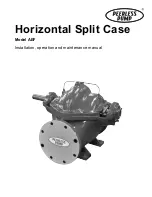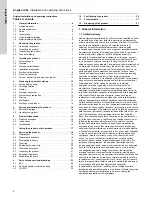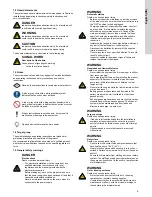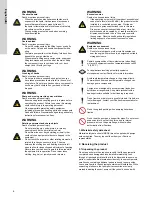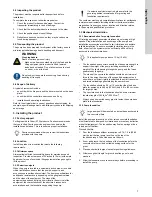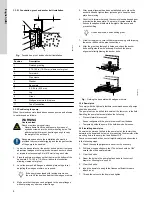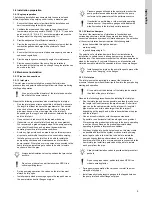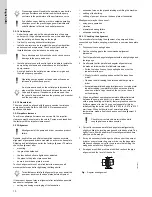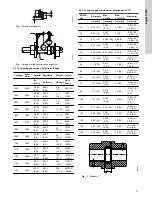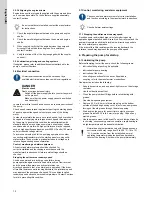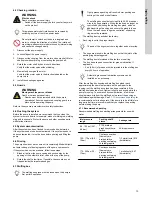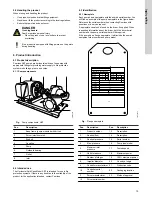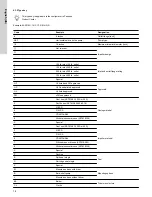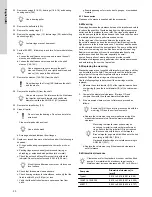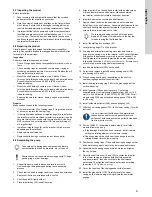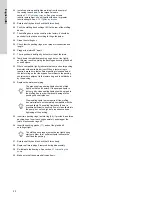
2.2 Inspecting the product
The product must be inspected after transport and before
installation.
To complete the inspection, follow the steps below:
1.
Check the product for transport damage. Contact the
transporter immediately in case of damage.
2.
Check that the delivered products correspond to the order.
3.
Check the positions and sizes of fittings.
4.
Retighten various connections, as they may have become
loose during transport.
2.3 Transporting the product
The pump has been prepared for shipment at the factory so as to
minimize potential damage due to handling and transport.
WARNING
Crushing hazard
Death or serious personal injury
‐
Make sure all persons stand clear of the load and the
lifting equipment while product is lifted, lowered,
loaded and unloaded. Do not allow anyone to stand
on, under, or near the load.
Do not subject the pump to excessive g-forces during
handling or transport.
2.4 Scope of delivery
A typical shipment will include:
•
one skid with the fire pump and the driver mounted on the base
plate
•
one skid with the controller and accessories, if any
•
installation and operating instructions.
Refer to the original order in case of questions about shipping, for
example, special arrangements with third-party vendors for shipping
and storage.
3. Installing the product
3.1 Factory support
For Engineered to Order (ETO) products, Peerless recommends
that you invite a Peerless service engineer to supervise the
installation and startup. This is to ensure a proper installation.
Peerless recommends that you review the instructions
provided with the pump.
3.2 Location
Install the product in a location that meets the following
requirements:
3.2.1 Minimum space
Always allow sufficient accessibility space for maintenance and
inspection. Provide a clearance of 24 inches (610 mm) with ample
head room for use of overhead lifting equipment strong enough to
lift the product.
3.2.2 Seismic analysis
When the pump is located in a seismically active area or in certain
critical installations, ensure that the pumps, supports, and
accessories are earthquake-resistant. The design specifications for
earthquake resistance vary depending on the geographical area
and the class of the equipment. The class of the
equipment depends on defining how critical is the survival of the
equipment, the characteristics of the structure's response to
accelerations, and the foundation supporting the pump.
If a seismic analysis is required, please refer to the
governing bodies recommended for grouting and
foundation requirements.
The customer must supply complete specifications for earthquake-
resistance requirements including seismic criteria, acceleration,
magnitudes, frequency spectrum, location and direction relative
to the pump and qualification procedure.
3.3 Mechanical installation
3.3.1 Recommendation for pump foundation
All rotating equipment generates vibrations when turning at high
speeds. Proper installation and anchorage of the pumps and
installation accessories are critical to limit vibrations and achieve
reliable installation. To ensure acceptable vibration levels in the
field, all parts of the system must be sufficiently stiff and firmly
anchored to minimize vibrations:
This applies for pumps above 13 hp (10 kW).
•
The foundation and concrete should be of adequate strength to
support the weight of the pump including accessories, the
weight of the liquid passing through the pump, and the forces
generated by the pump.
•
The mass of the concrete foundation should be a minimum of
three to five times the mass of the supported equipment and
should have sufficient rigidity to withstand the axial, transverse,
and torsional loadings generated by these machines.
•
The foundation should be 5.9 in (15 cm) wider than the base
plate for pumps up to 469 hp (350 kW) and 9.8 in (25 cm) wider
for larger pumps.
•
The concrete used in the foundation should have a minimum
tensile strength of 362 lb
f
/in
2
(250 N/cm
2
).
•
Always use a non-shrink epoxy grout to fasten the pump base
plate to the foundation.
3.3.2 Pump foundation
Large pumps will be mounted on a steel base anchored to
two concrete pillars.
Install the pump permanently on a firm, raised concrete foundation
of sufficient size to dampen any vibration and prevent any deflection
or shaft misalignment. The foundation may float on springs or be a
raised part of the floor.
Proceed like this:
1.
Pour the foundation without interruption to 0.75- 1.5 in (20-40
mm) below the final pump level. Leave the top of the
foundation rough. Then clean and wet it down.
2.
Scour and groove the top surface of the foundation before the
concrete sets to provide a suitable bonding surface for the
grout.
3.
Place anchor bolts in pipe sleeves for positioning allowance.
4.
Allow enough bolt length for grout, base flange, nuts, and
washers.
5.
Allow the foundation to cure several days before proceeding to
install the pump.
7
English (US)

